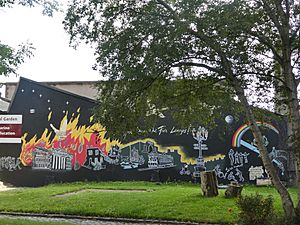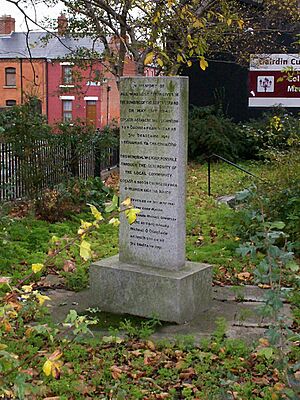Bombing of Dublin in World War II facts for kids
During World War II, the city of Dublin in Ireland was bombed several times by German planes. The first bombs fell early on 2 January 1941 in the Terenure area. The next day, more bombs hit houses on Donore Terrace near the South Circular Road. Luckily, no one died in these early attacks, but many people were hurt.
Later that year, on 31 May 1941, four German bombs hit north Dublin. One bomb damaged Áras an Uachtaráin, which is the home of the Irish President. The worst damage happened in the North Strand area, where 28 people were killed. However, the very first bombing in the Republic of Ireland happened earlier, on 26 August 1940. German planes, called the Luftwaffe, bombed Campile in County Wexford, killing three people.
Contents
Why Ireland Was Bombed
At the start of World War II, Ireland decided to stay neutral. This meant they would not pick a side in the war. They called this time "The Emergency". By July 1940, Germany had taken over many countries in Europe. Britain and its allies were left to fight Germany alone.
By May 1941, the German Air Force had bombed many British cities. This was part of "The Blitz". Belfast in Northern Ireland was also bombed. Northern Ireland was part of the United Kingdom, so it was at war. But the independent country of Ireland was neutral. German bombings aimed at the United Kingdom became less frequent after Germany attacked Russia in June 1941.
German Bombings in Ireland: A Timeline
Even though Ireland was neutral, it was bombed several times:
- 26 August 1940: Five German bombs fell on County Wexford during the day. One bomb hit the Shelbourne Co-operative Creamery in Campile. Three people were killed. In 1943, the German government paid £9,000 to help the victims.
- 20 December 1940: Two bombs fell on Glasthule near Dún Laoghaire around 7:30 PM. Three people were injured. About 30 minutes later, a third bomb fell near Carrickmacross in County Monaghan, slightly injuring one person.
- 1–2 January 1941: Bombs fell in many counties, including Meath, Carlow, Kildare, Wicklow, Wexford, and Dublin.
* In Meath, five bombs fell at Duleek and three at Julianstown, but no one was hurt. * In Carlow, a house in Knockroe was destroyed, killing three people and injuring two. * In Kildare, three large bombs and many smaller fire bombs fell in the Curragh area. * Two sea mines were dropped by parachute near Enniskerry in Wicklow. * Ballymurrin in Wexford saw three German bombs fall, with no injuries. * In Dublin, bombs hit Terenure. Two fell at Rathdown Park, and two more at Fortfield Road and Lavarna Grove. People were injured, but no one died.
- 3 January 1941: Dublin was bombed again by the German Luftwaffe. Bombs fell on Donore Terrace in the South Circular Road area. 20 people were injured, but no one died.
- 31 May 1941: The most serious attack happened when four German bombs fell on North Dublin in the North Strand area. This attack killed 28 people.
- 1 June 1941: Arklow was bombed by the Luftwaffe, but no one was hurt.
- 24 July 1941: Bombs fell on Dundalk, causing only minor damage and no injuries.
Attack on Blackrock Island
On 20 August 1940, a German bomber attacked Blackrock Island. This was six days before the Campile bombing. The plane fired its guns at the lighthouse, damaging its windows and roof.
The Dublin Bombings in Detail
Terenure Bombing
Around 10 AM on 2 January 1941, two bombs were dropped in Rathdown Park, Terenure. The first bomb landed in soft ground, making a big hole but not much other damage. The second bomb landed behind houses at 25 and 27 Rathdown Park. It destroyed these two houses and damaged many nearby homes.
Two other bombs fell near the Kimmage Crossroads (KCR). They landed on undeveloped land because Lavarna Grove was still being built. This meant there was little damage, and only one person was injured. No one died.
Donore Terrace Bombing
Just before 4 AM on 3 January 1941, a bomb hit the back of houses at 91 and 93 Donore Terrace. This was in the South Circular Road area of Dublin. Three houses were completely destroyed. About 50 other houses were damaged. Donore Presbyterian Church, its school, and the Jewish Synagogue nearby were also damaged. 20 people were injured, but thankfully, no one was killed.
North Strand Bombing
In the early morning hours of 31 May 1941, four German bombs fell on north Dublin. That night, Irish military observers saw many German planes. Searchlights tried to track them. The planes were not flying in a straight line; they seemed to be flying around randomly.
When the German planes did not leave Dublin's airspace, the Irish Army fired warning flares. First, they fired three flares with the colours of the Irish flag. This was to tell the pilots they were over a neutral country. Then, they fired red flares, warning the planes to leave or be shot at. After 15 minutes, Irish anti-aircraft guns began firing at the bombers. However, Dublin's air defenses were not very strong, and the gunners were not well trained. They had powerful shells, but they could not hit the planes.
The bombers kept flying over the city for almost an hour while being shot at. At 1:28 AM, a bomb fell on the city. Another bomb fell one minute later, and a third two minutes after that. Some German planes then flew away, but others stayed. The anti-aircraft guns stopped firing.
One German plane flew north but was fired on near Collinstown. It then turned around and came back over Dublin, circling the city and flying low sometimes. Anti-aircraft guns fired at it again. The plane kept flying around for almost half an hour, dodging shells and searchlight beams. It flew lower and lower, and machine guns fired at it. Finally, it dropped a bomb at 2:05 AM.
Of the first three bombs:
- One fell in the Ballybough area. It destroyed two houses at 43 and 44 Summerhill Park. Many people were injured, but no one died.
- Another fell near the Zoo in Phoenix Park. This bomb caused no injuries but damaged Áras an Uachtaráin, the home of the Irish President.
- The third bomb made a large hole in the North Circular Road near Summerhill. Again, no one was injured.
The fourth and final bomb, dropped about half an hour later, fell in North Strand. This was the most tragic attack. It killed 28 people. It destroyed 17 houses and badly damaged about 50 others. The worst damage was between Seville Place and Newcomen Bridge. 90 people were injured. About 300 houses were destroyed or damaged, leaving around 400 people without homes.
On 5 June, a funeral was held for 12 of the victims. Éamon de Valera, who was the leader of Ireland (called the Taoiseach), and other government officials attended. De Valera spoke in the Dáil Éireann (the Irish Parliament) that day. He said that the Dáil shared the sorrow of the people who lost loved ones. He also thanked the volunteers who helped after the disaster. He confirmed that a protest had been made to the German government.
After the war, West Germany accepted responsibility for the bombing. By 1958, they paid £327,000 in compensation. This money came from Marshall Aid, which was American help for Europe after the war. The Irish government processed over 2,000 claims for compensation, costing £344,000 in total. East Germany and Austria, which were part of Nazi Germany in 1941, did not contribute any money.
Why Did the North Strand Raid Happen?
People have suggested several reasons for the North Strand bombing. German Radio said it was impossible that Germans bombed Dublin on purpose. German and Allied airmen were being held in Ireland because it was neutral.
One possible reason was a mistake in navigation. One of the German pilots on the raid later said this. Many large cities in the United Kingdom were bombed, including Belfast, which is across the Irish Sea from Great Britain, just like Dublin. Germany's apology during the war and its payment of compensation after the war suggest it was a navigation error.
Another idea is that it was a warning to Ireland. In April 1941, Germany had heavily bombed Belfast. Ireland sent rescue workers, firefighters, and emergency teams to help Belfast. De Valera formally protested the bombing to Germany. He also gave a famous speech saying, "they are our people." Some people believe the Dublin bombing was a warning to Ireland to stay out of the war. Colonel Edward Flynn, a relative of an Irish minister, remembered that Lord Haw Haw had warned Ireland. Lord Haw Haw was a British traitor who broadcast German propaganda. He warned that Dublin's Amiens Street Railway Station would be bombed. This station is very close to North Strand Road, where the damage was worst. Flynn also thought the bombing of Dundalk on 4 July was a warning because Dundalk was where Irish cattle were shipped to the United Kingdom.
After the war, Winston Churchill, the British Prime Minister, suggested that the bombing might have been an accident. He said it could have been caused by Britain interfering with German radio signals. These signals, called "Y," helped German bombers find their targets. This interference was part of the Battle of the Beams. However, the technology was not advanced enough in 1941 to redirect planes from one target to another. It could only make it harder for bombers to receive the signals.
See also
- Battle of the Beams
- Bombings of Switzerland in World War II - bombings of another neutral country
Images for kids





